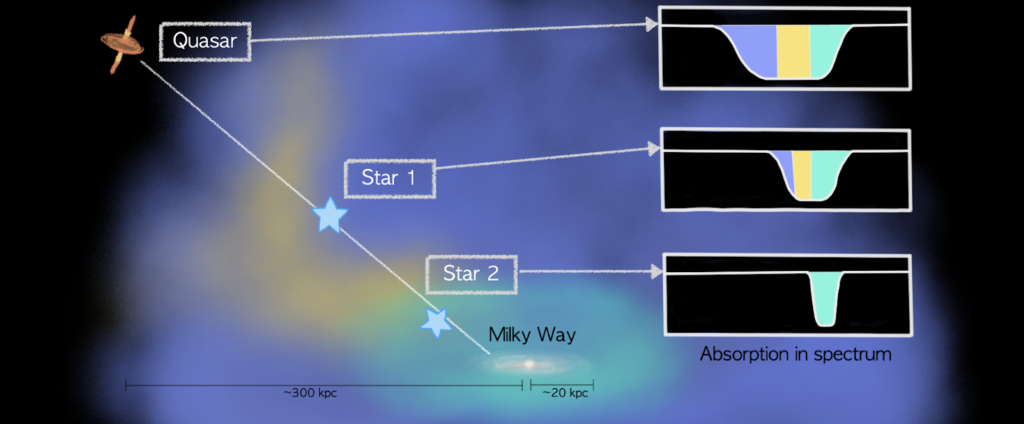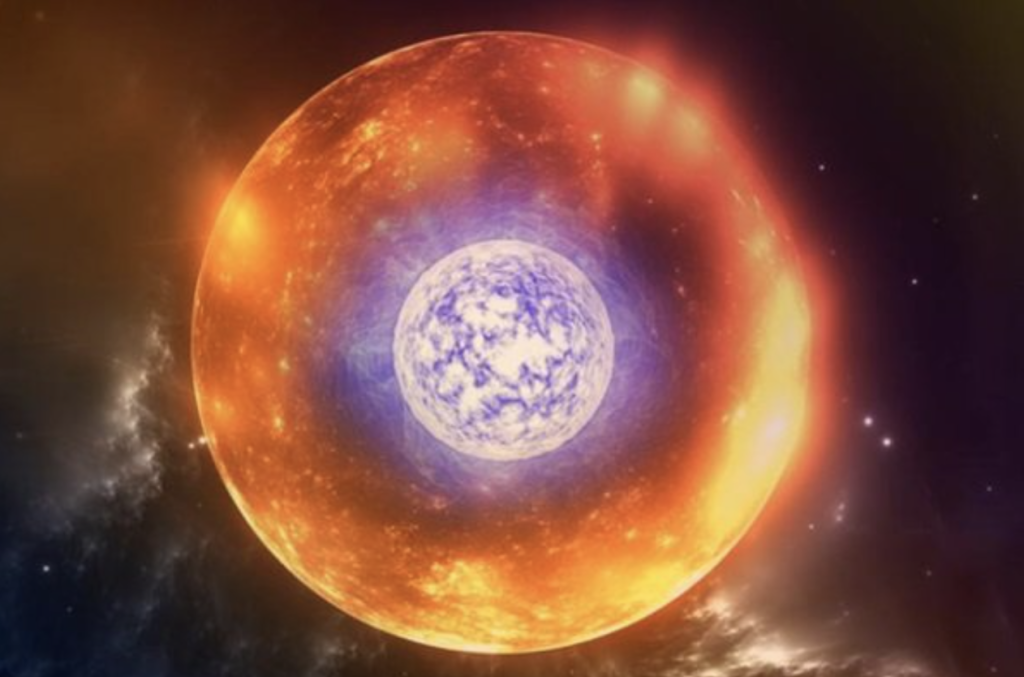Roughly half of the coursework in Pre-MAP will be spent working on a research project in a very small group with mentors from the Astronomy Department, such as graduate students, postdoctoral fellows, or faculty advisors. The research projects typically advance the research goals of your mentor, and so the projects that we offer cover a variety of topics and size-scales from stars to galaxies.
Title: Analyzing a Microlensing Event with a Binary Lens
Mentor: David Wang
Students: Ananya Garg, Ari Rosenmader
Microlensing events happen when an astronomical object, such as a star, passes in front of a background star. Gravity of the “lens star” causes the “source star” to temporarily appear brighter, since light not initially directed at Earth bends around the lens star and thus reaches Earth. When the lensing source has two components: for example two stars, or a star and a planet, the effective magnification is more complex, and the measured brightness of the source can peak multiple times. In this project, we will measure the brightness of such a microlensing event over 4 days by processing data taken with the ARCSAT telescope at Apache Point Observatory, and combine these measurements with public data from ATLAS and ZTF. We will then model the lightcurve of this event to fit some characteristics of the lensing system.
Title: Searching for Mysterious Main-Sequence Dipper Stars in Clusters as Keys of Stellar Age
Mentor: Andy Tzanidakis
Students: Cassidy Johnson, Tessa Ward
Main-sequence dipper stars are stars that show sudden and irregular drops in brightest, but only a handful of such stars have been discovered so far. Finding more of these mysterious stars is important for understanding what might be causing these dimming events. One possibility is that material around these stars, like leftover material from planet formation, comets, or colliding planets, could be blocking their light. By studying these stars, we can learn more about how planets form and change over time. The following research student will focus on searching for these stars in stellar clusters where we have good estimates of the overall age of the stars, helping us answer the question about how these dimming events relate to the age, and environment around these stars. The project will be using data from Gaia spacecraft, and a ground-based survey called the Zwicky Transient Facility (ZTF).
Title: The impact of binary stars on the Galactic Underworld
Mentors: Tom Wagg and Lauryn Williams
Students: Hannah Kann, Cavin Ehlert
This project is about making predictions for the galactic underworld – where are all of the black holes and neutron stars located in the galaxy? Black holes and neutron stars are formed after a supernova, which can produce a strong “kick” sending the object flying off through the galaxy. This means that the locations you’d expect to find them are very different from the less dramatic regular stars. This was demonstrated in a great paper (Sweeney+2022), which produced the lovely figure attached. BUT, this paper made a critical simplifying assumption – they assumed all black holes and neutron stars were formed as single stars. However, we know that the vast majority of massive stars that form black holes or neutron stars are binary stars (two stars orbiting) one another, so each system could get two supernova kicks. In this project we’ll use a new code called cogsworth to simulate the Milky Way’s galactic underworld and investigate how binaries change the landscape. We’ll aim to produce a plot just like the one below, but showing a before/after with or without binaries.
Title: Mapping the Milky Way’s Atmosphere
Mentors: Bonni Choi and Sierra Bet
Students: Annabelle Lin

In this project, you will investigate the atmosphere of the Milky Way. Our Milky Way galaxy is surrounded by gas of varying temperatures and densities. From spectral data of stars and quasars, you will find clouds and gas flows in this atmosphere by analyzing absorption features they produce. Some of these gaseous structures may be hot, while others could be cooler. Different ions trace these temperature variations, allowing you to explore how hot and cool gas is distributed in the Milky Way’s atmosphere. By using sources at different distances, you will be able to gain insights into how the Milky Way’s atmosphere changes by distance.
Title: Tracking the launching of galactic winds
Mentors: Adrian Plenefisch, Tom Quinn, and Oge Okoronkwo
Students: Naomi Morato
Many galaxies show vigorous outflows of hot gas away from their stellar disks (see the composite image of M82). While the prevailing model explains these winds as due to explosions of massive stars (supernovea), it is unclear whether such supernovae have sufficient energy to drive these winds. In particular, the winds have to fight the overall gravity of the galaxy and dark matter, and the have to penetrate to surrounding galactic atmosphere (the Circumgalactic Medium). This project will analyze simplified simulations of winds being driven by supernovae to see how far and fast such winds go.
Title: Identifying Thorne-Żytkow Object Candidates using APOGEE and Gaia
Mentors: Lauryn E. Williams
Students: Kimberly McCartney

Thorne-Żyktow Objects (TŻOs) are a hypothetical class of star where there is a neutron star at the core of a large, diffuse envelope, predicted to have a similar look to a red supergiant star. TŻOs can have unusual abundances in their atmospheres, which is the product of their unique nucleosythesis coined the ‘interrupted-rapid-proton’ process. Their chemical signatures include: Rb, Sr, Y, Zr, Mo, and Li. The search for TŻOs has been ongoing with the discovery of HV2112 by a team led by Emily Levesque, a star that has similar abundances to what we expect a TŻO to have. This project aims to follow in the footsteps of the observational efforts by identifying TŻO candidates by analyzing stars in the APOGEE database, focusing on their chemical abundances, temperatures and their matching Gaia properties like luminosity and distance.
Title: The Gas Structure of the Cosmic Web
Mentors: Charlie Willard
Students: Maya Berhane
Our understanding of the large scale matter structure of the universe, called the Cosmic Web, is largely motivated by extremely massive simulations of the universe. Observations of galaxy populations along this cosmic web, as well as the absorption of light due to neutral hydrogen gas (called the Lyman-Alpha forest), offer concrete evidence for the big-picture of the cosmic web. However, we still rely heavily on simulations for detailed exploration of the states of matter between galaxies.
This project will use the data from a flagship simulation of the universe, IllustriusTNG, to explore the gas of different structures within the cosmic web: filaments vs. nodes. We will use a data visualization package in python to create images and plots of the matter within the cosmic web. We want to understand how the gas within filaments differs from the gas within nodes, and how both vary over different epochs of the universe. And lastly we will explore how different mass-resolutions used for the simulation can change the answers to these questions, to better understand how much we can rely on simulations for an accurate picture of the universe!
